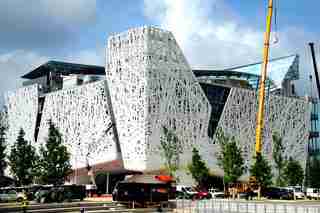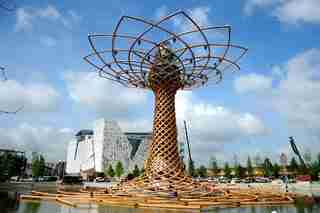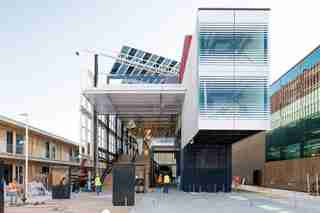
dam-images-architecture-2015-05-milan-expo-2015-pavilions-milan-expo-2015-pavilions-02.jpg
The Palazzo Italia, designed by Nemesi & Partners as part of the Italian Pavilion, is wrapped by basketlike concrete panels with patented technology: When activated by light, they are designed to capture pollution in the air and transform it into salt, thereby reducing smog.

dam-images-architecture-2015-05-milan-expo-2015-pavilions-milan-expo-2015-pavilions-01.jpg
Expo Milano 2015, which opened May 1, presents an entire temporary village of ambitious architectural structures created by more than 140 participating countries, international organizations, and corporations. All are based on the theme “Feeding the Planet, Energy for Life.” This slide show highlights just a handful of the pavilions that promise to wow fairgoers until the event’s conclusion on October 31. Pictured here is the Tree of Life in Lake Arena, which will offer displays of water effects, fire, light, and sound as part of the Italian Pavilion.

dam-images-architecture-2015-05-milan-expo-2015-pavilions-milan-expo-2015-pavilions-04.jpg
Inside the USA Pavilion, the promenade is made from salvaged Coney Island boardwalk. Above, a rooftop terrace is shaded by panes of digitally controlled SPD-SmartGlass, which automatically switches from clear to opaque in response to environmental conditions.
dam-images-architecture-2015-05-milan-expo-2015-pavilions-milan-expo-2015-pavilions-06.jpg
For the exposition’s central square, Libeskind also designed four aluminum sculptures commissioned by Siemens. Named The Wings, the curvaceous pieces rise 32 feet and curl to form silvery canopies overhead. They are also packed with audiovisual components: Thousands of embedded LEDs present light shows mimicking starlings taking flight while speakers emit a sounds the sounds of nature and urban life.
dam-images-architecture-2015-05-milan-expo-2015-pavilions-milan-expo-2015-pavilions-03.jpg
Based on the theme “American Food 2.0: United to Feed the Planet,” architect James Biber designed the 35,000-square-foot USA Pavilion with a façade that doubles as an expansive 7,000-square-foot vertical garden. Not merely for show, the garden, which is planted with 42 varieties of vegetables, grains, and herbs, will be periodically harvested during the expo.
dam-images-architecture-2015-05-milan-expo-2015-pavilions-milan-expo-2015-pavilions-05.jpg
For a pavilion sponsored by the Chinese real-estate company Vanke, architect Daniel Libeskind designed a sinuous 8,600-square-foot structure that evokes a curled dragon. The slumbering beast of a building is clad in more than 4,000 shimmering red metalized ceramic tiles. Inside, an exhibition designed by Ralph Appelbaum Assoc. presents a forest of bamboo scaffolding supporting 200 video screens that tell stories of food and shared meals.
dam-images-architecture-2015-05-milan-expo-2015-pavilions-milan-expo-2015-pavilions-07.jpg
The U.K. Pavilion, designed by a team led by artist Wolfgang Buttress, is sure to be one of the most memorable of the expo. The centerpiece is the Hive, an ethereal beehive-inspired structure fabricated by Stage One. Constructed from 169,300 custom aluminum components, it’s laced with LEDs and speakers that react to activity in a beehive in Nottingham, England.
dam-images-architecture-2015-05-milan-expo-2015-pavilions-milan-expo-2015-pavilions-08.jpg
The China Pavilion was designed by New York–based architect Yichen Lu of Studio Link-Arc. The 49,000-square-foot structure features an undulating timber frame roof covered with bamboo-and-aluminum panels. Inside, an array of tightly clustered LED tubes, meant to evoke a field of wheat, is animated with shifting light patterns.
dam-images-architecture-2015-05-milan-expo-2015-pavilions-milan-expo-2015-pavilions-09.jpg
The form of the Mexico Pavilion, designed by architect Francisco López Guerra Almada, is inspired by one of the country’s most important food staples—corn. Wrapped by curved fabric-covered panels that represent dried cornhusks, the building invites visitors to enter, no shucking required.
dam-images-architecture-2015-05-milan-expo-2015-pavilions-milan-expo-2015-pavilions-10.jpg
Designed by the Office of Bangkok Architects, the central element of the Thailand Pavilion is a volcano-shaped timber structure inspired by the ngob —a traditional ventilated hat worn by Thai farmers that is used only in their country.
dam-images-architecture-2015-05-milan-expo-2015-pavilions-milan-expo-2015-pavilions-11.jpg
The Malaysia Pavilion, designed by Hijjas Kasturi Assoc., resembles four supersize seeds. The pods are made from frameworks of glulam (glued laminated timber) components, connected by some 3,000 steel joints.
dam-images-architecture-2015-05-milan-expo-2015-pavilions-milan-expo-2015-pavilions-12.jpg
Vatican City never looked so avant-garde. Recognized as one of the participating countries, its angular pavilion is covered with biblical phrases—“Give us our daily bread” and “Not by bread alone”—in a multitude of languages.
